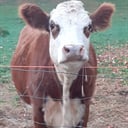Which of these sirenian species is extinct?
Steller's sea cow (Hydrodamalis gigas) is an extinct sirenian (sea cow) discovered by Europeans in 1741. At that time, it was found only around the Commander Islands in the Bering Sea between Alaska and Russia; its range was more extensive during the Pleistocene epoch, and it is possible that the animal and humans previously interacted. Some 18th-century adults would have reached weights of 8–10 t (8.8–11.0 short tons) and lengths up to 9 m (30 ft).
It was a part of the order Sirenia and a member of the family Dugongidae, of which its closest living relative, the 3 m (9.8 ft) long dugong (Dugong dugon), is the sole surviving member. It had a thicker layer of blubber than other members of the order, an adaptation to the cold waters of its environment. Its tail was forked, like that of cetaceans. Lacking true teeth, it had an array of white bristles on its upper lip and two keratinous plates within its mouth for chewing. It fed mainly on kelp, and communicated with sighs and snorting sounds. Evidence suggests it was a monogamous and social animal living in small family groups and raising its young, similar to extant sirenians.
More Info:
en.wikipedia.org





